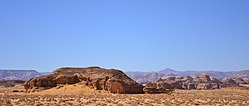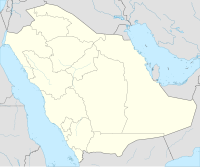Land of Tema
Tayma | |
|---|---|
 Landscape near Tema | |
| Coordinates:27°37′47″N38°32′38″E/ 27.62972°N 38.54389°E |
The Land of Tema,Te'-maorTemaArabic:تيماءandThaiman) is a place mentioned in the Bible[1][2]where the descendants ofIshmael's son Tema dwelt.[citation needed]InHebrew,the name means "south country".[citation needed]It was most likely innorthernSaudi Arabiaand has been identified with the modernTeima',[3][1][2][4]anoasis(fitting with the description in Jeremiah) which lies about 200 miles (320 km) north ofMedina,and some 40 miles (64 km) south ofDumat(Dumah), now known asel-Jauf.Teima' is on the ancientcaravanroad connecting thePersian Gulfwith theGulf of Aqabawhich in antiquity bought wealth to the town.[5][6]Doughty has described atTeimathe ruins of an old city wall 3 miles (4.8 km) in circuit.[7]AnAramaicstelerecently discovered, belonging to the 6th century BC, shows the influence ofAssyrianin the town. The place is mentioned in thecuneiforminscriptions.[8][9]The possibility of its being on atrade routeis supported by the reference inJob6:19.[10]It is often associated withthe Land of Dumah.[citation needed]
The Bible mentions Tema several times, includingIsaiah21:14;Jeremiah25:23, 49:7, 49:20;Obadiah1:9; andAmos1:12. One of the protagonists in Job isEliphaz the Temanite,and Genesis 36 refers toHushamof the land of the Temanites.
Outside of the Bible, it was mentioned byPtolemy,[11]Pliny,[12]Agatharchides,[13][14]andJosephus.[15]It was noted as halfway betweenDamascusandMecca,and between Babylonia and Egypt.[16]Yaqutmentions that in theMiddle Ages,it was inhabited by aJewishCommunity.[17]Nabunaidof Babylon captured the city[18][3]and settled there untilCyrus the Greatcaptured the city and moved him toCarmania.
References
[edit]- ^abS. Smith, Babylonian Historical Texts (1924), 98-123
- ^abArnulf Hausleitner, "Tayma - eine frühe Oasensiedlung", in: Archäologie in Deutschland, 3/213, pp. 14–19
- ^abR. P. Dougherty, Nabonidus and Belshazzar. (1929) p 1-5-200
- ^Rev Charles Foster,The historical geography of Arabia; or, The patriarchal evidences of revealed religion. With an appendix containing translations of the Hamyaritic inscriptions recently discovered in Hadramaut,Volume 1 (1844)p 294.
- ^See Job 6:19
- ^See:Isaiah 21:14
- ^R. P. Dougherty, Arabia Deserta, I, p285
- ^Schrader, KAT2, 149
- ^Temaat BibleAtlas.
- ^Alter, Robert(2019).The Hebrew Bible: The Writings.Norton.
- ^Ptolemy 5:19, section 6
- ^Pliny, Geogr. 5, 19 and Hist. Nat. 6:32
- ^Rev Charles Foster,The historical geography of Arabia; or, The patriarchal evidences of revealed religion. With an appendix containing translations of the Hamyaritic inscriptions recently discovered in Hadramaut,Volume 1 (Duncan and Malcom, 1844)p294.
- ^AgatharchidesLXX
- ^Josephus Antiquities X.xi.2
- ^Rodolfo C. Estimo Jr. (7 November 2010). "Pharaonic inscription found in Saudi Arabia". ArabNews.
- ^Yaqut,Šihāb al-Dīn ibn ‘Abd Allah al-Ḥamawī. "Mu’jam al-Buldān". Dār Ṣādir, Beirut 1995, p. 67
- ^Jack Finegan, Light from the Ancient Past, Vol. 1: The Archaeological Background of the Hebrew-Christian Religion (Princeton University Press, 8 Dec. 2015)p190.

